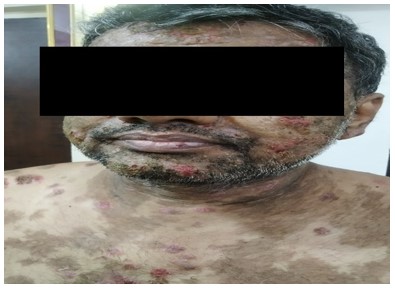Understanding the treatment modalities of Pemphigus Vulgaris (Agnivisarpa) through the lens of Ayurveda - A Single Case Study
DOI:
https://doi.org/10.21760/jaims.9.3.40Keywords:
Agnivisarpa, Pemphigus, Raktamokshana, Virechana Karma, AyurvedaAbstract
Pemphigus is a disease that causes blisters and sore on the skin or mucous membrane. The blisters rupture easily, leaving open sores, which may ooze and become infected. Agnivisarpa can be compared to pemphigus vulgaris due to its resemblance in sign and symptoms. The disease needs early and proper treatment to prevent further morbidity and mortality. Being an autoimmune disorder physician generally use corticosteroids and immunosuppressive drugs here an attempt is made to study in detail about pemphigus vulgaris and its understanding though Ayurveda. A case report of 47year old male patient with clinical presentation of fluid filled blisters burning and pain along with hyperpigmentation received systemic medication in modern medicine without an adequate response. Samshodhan coupled with Samshamana medication are the cornerstones for Visarpa. Hence in this study, Virechana Karma once in a week for 2 month. After that Raktamokshana (After completion of 3 sitting of Virechana Karma) followed by 3 months of Samshamana medicine. At the conclusion of treatment, a skin lesion assessment was performed.
Downloads
References
K. Tsunoda, T. Ota, M. Saito et al., “Pathogenic relevance ofIgG and IgM antibodies against desmoglein 3 in blister for-mation in pemphigus vulgaris,” -e American Journal ofPathology, vol. 179, no. 2, pp. 795–806, 2011.
C. M. Hammers and J. R. Stanley, “Mechanisms of disease: pemphigus and bullous pemphigoid,” Annual Review of Pathology: Mechanisms of Disease, vol. 11, no. 1, pp. 175–197,2016.
Sastri K., Kushtha Chikitsa. Pandeya G. (ed.), Charak Samhita, Vidhyotinitika vol.2, Chaukhambha Sanskrit, Varanasi, 2009; 7/21-25: 243.
Agnivesa, Caraka Samhita. Ayurveda Dipika Commentary of Cakrapanidatta, edited by Vaidya Jadavji Trikamji Acharya. Chikitsa Sthana; Chapter 21, Verse 36. Varanasi: Chaukamba Krishnadas Academy, 2010; 561: 21 – 36.
Agnivesa, Caraka Samhita. Ayurveda Dipika Commentary of Cakrapanidatta, edited by Vaidya Jadavji Trikamji Acharya. Chikitsa Sthana. Varanasi: Chaukamba Krishnadas Academy, 2010; 559: 21 – 11.
Susruta, Susruta Samhita. Nibandhasangraha commentary by Sri Dalhanacarya, edited by Vaidya Jadavji Trikamji Acharya. Nidana Sthana; Varanasi: Chaukamba Krishnadas Academy, 2013; 306: 10 – 3
Yadavji Trikamji, Charak Samhita, Published by Chowkhamba orientala, Varanasi, 2017 ed, Chikitsasthana, Chapter 21, Shloka 141, Page no. 566.
Vagbhata, Astanga Hrdayam English commentary volume 2 translated by Prof. K.R.Srikantha Murthy : Chowkhamba Krishnadas Academy Chiktisa Sthana chapter No. 181 page no.59
Vagbhata, Astanga Hrdayam English commentary volume 2 translated by Prof. K.R.Srikantha Murthy : Chowkhamba Krishnadas Academy Chiktisa Sthana chapter 188 page no.466















